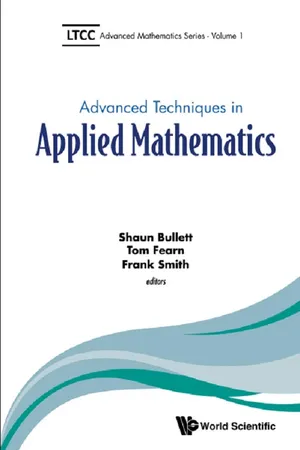
- 204 pages
- English
- ePUB (mobile friendly)
- Available on iOS & Android
Advanced Techniques in Applied Mathematics
About this book
This book is a guide to advanced techniques used widely in applied mathematical sciences research. Chapter by chapter, readers will be led from a foundation level understanding to advanced level understanding. This is the perfect text for graduate or PhD mathematical-science students looking for support in techniques such as practical analytical methods, finite elements and symmetry methods for differential equations.
Advanced Techniques in Applied Mathematics is the first volume of the LTCC Advanced Mathematics Series. This series is the first to provide advanced introductions to mathematical science topics to advanced students of mathematics. Edited by the three joint heads of the London Taught Course Centre for PhD Students in the Mathematical Sciences (LTCC), each book supports readers in broadening their mathematical knowledge outside of their immediate research disciplines while also covering specialized key areas.
Contents:
- Practical Analytical Methods for Partial Differential Equations (Helen J Wilson)
- Resonances in Wave Scattering (Dmitry V Savin)
- Modelling — What is it Good For? (Oliver S Kerr)
- Finite Elements (Matthias Maischak)
- Introduction to Random Matrix Theory (Igor E Smolyarenko)
- Symmetry Methods for Differential Equations (Peter A Clarkson)
Readership: Researchers, graduate or PhD mathematical-science students who require a reference book that covers advanced techniques used in applied mathematics research.
Key Features:
- Gives advanced technique used in applied mathematics research
- Each chapter is written by a leading lecturer in the field
- Concise and versatile
- Can be used as a masters level teaching support or a reference handbook for researchers
Frequently asked questions
- Essential is ideal for learners and professionals who enjoy exploring a wide range of subjects. Access the Essential Library with 800,000+ trusted titles and best-sellers across business, personal growth, and the humanities. Includes unlimited reading time and Standard Read Aloud voice.
- Complete: Perfect for advanced learners and researchers needing full, unrestricted access. Unlock 1.4M+ books across hundreds of subjects, including academic and specialized titles. The Complete Plan also includes advanced features like Premium Read Aloud and Research Assistant.
Please note we cannot support devices running on iOS 13 and Android 7 or earlier. Learn more about using the app.
Information
Chapter 1
Practical Analytical Methods for Partial Differential Equations
Gower Street, London WC1E 6BT, UK
[email protected]
1.Introduction
2.First-order PDEs
2.1.Wave equation with constant speed




2.2.Characteristics
Table of contents
- Cover
- Halftitle
- Series Editors
- Title
- Copyright
- Contents
- Preface
- 1. Practical Analytical Methods for Partial Differential Equations
- 2. Resonances in Wave Scattering
- 3. Modelling — What is it Good For?
- 4. Finite Elements
- 5. Introduction to Random Matrix Theory
- 6. Symmetry Methods for Differential Equations